VI.
PLANT COMMUNITIES
F. SERPENTINITE COMMUNITIES AND COMMUNITIES
OF ROCK OUTCROPS
1. SERPENTINITE COMMUNITIES
In
Poly Canyon some grasslands, chaparral, coastal scrub,
coastal live oak woodlands, and rock outcrop communities
occur on serpentinite-derived soils. The unique demands
of such soils are visible to us through changes in
the vegetation occurring on them. "Serpentine barrens"
is a name commonly associated with the paucity of
vegetation in these areas. Serpentinitic soils support
relatively fewer species, some of which are the same
as those occurring on adjacent non-serpentinitic soils,
others which occur only on the serpentinite. These
plants tend to have numerous xeromorphic traits or
characteristics that reflect the unavailability of
moisture: dwarfism or nanism (smaller plant size);
smaller leaf size; sclerophylls (leaves with lignified
or hardened, woody surfaces); drought-deciduous leaves;
and/or enlarged root systems.
Plants
on serpentinitic soils may have chlorotic (pale or
yellowed, malnourished) leaves. The infertility of
serpentinitic soils is due to numerous factors. One
factor is the absence or scarcity of one or more
required elements: primary plant nutrients such
as nitrogen, potassium, and phosphorus, as well as
calcium. A second factor involves the unavailability
of plant nutrients present. This can be caused
by two things. First, the pH (typically 6.8) of these
soils makes some primary plant nutrients unavailable.
Second, under certain conditions, elements such as
nickel, chromium, cobalt, and magnesium can inhibit
the uptake of more beneficial nutrients. For example,
the presence of magnesium can be antagonistic to the
uptake of calcium. A third factor is the excellent
drainage of these soils due to the relative absence
of organic matter. This facilitates the leaching away
of nutrients. A fourth factor is lower vegetative
cover. As less plant litter is deposited, less
organic matter becomes available in the soil to provide
recycled nutrients for the plant cover, to hold moisture
and nutrients in the soil, or to modify the direct
exposure and also color (and, therefore, temperature
and humidity) of the soil.
Four
types of ecological responses by vegetation to serpentinite
have been hypothesized. Endemic or obligate
plants are restricted to serpentinite. Some studies
suggest that serpentinite endemics actually grow equally
well on non-serpentinitic soils until they are plagued
by fungi or weedy vascular plants which do not survive
on serpentinite. However, no evidence has been found
to support the hypothesis that serpentinite endemics
require certain nutritional elements found only in
this substrate. Local or regional indicator
plants are not restricted to serpentinite, but
occur on serpentinite in areas well outside their
normal ranges of distribution. Tolerant, facultative,
indifferent, ubiquist, or bodenvag
species are ecotypic variants of localized races
of wide-ranging species which have developed a genetic
tolerance to serpentinitic soils. Such plants typically
exhibit somewhat different growth habits on and off
the serpentinite. Non-excluded species are
those plants which do not avoid serpentinite. See
Table 14.
The
relationship of animals to serpentinite has been addressed
by some studies. Of these, several apply to species
which occur in Poly Canyon.
Table
14.
SERPENTINITE AND VEGETATION
| Some
Serpentinite Endemics |
| Arctostaphylos
obispoensis (Ericaceae) |
|
| Calochortus
obispoensis (Liliaceae) |
|
| Chorizanthe
breweri (Polygonaceae) |
|
| Dudleya
abramsii ssp. murina (Crassulaceae) |
|
| Some
Local Serpentinite Indicators |
| Allium
lacunosum (Liliaceae) |
Chorizanthe
breweri (Polygonaceae) |
| Lomatium
parvifolium (Apiaceae) |
Fremontodendron
californica (Sterculiaceae) |
| Streptanthus
glandulosus (Brassicaceae) |
Perideridia
pringlei (Apiaceae) |
| Some
Bodenvag (Indifferent) Taxa |
| Allium
spp. (Liliaceae) |
Bromus
spp. (Poaceae) |
| Carex
spp. (Cyperaceae) |
Cercocarpus
betuloides (Rosaceae) |
| Chlorogalum
pomeridianum (Liliaceae) |
Eriogonum
spp. (Polygonaceae) |
| Festuca
spp. (Poaceae) |
Holodiscus
discolor (Rosaceae) |
| Hordeum
spp. (Poaceae) |
Juncus
spp. (Juncaceae) |
| Melica
spp. (Poaceae) |
Mimulus
spp. (Scrophulariaceae) |
| Pentagramma
triangularis (Pteridaceae) |
Plantago
erecta (Plantaginaceae) |
| Poa
spp. (Poaceae) |
Polygonum
spp. (Polygonaceae) |
| Pteridium
aquilinum (Dennstaedtiaceae) |
Rhamnus
spp. (Rhamnaceae) |
| Ribes
spp. (Grossulariaceae) |
Salix
spp. (Salicaceae) |
| Salvia
columbariae (Lamiaceae) |
Stipa
spp. (Poaceae) |
| Toxicodendron
diversiloba (Anacardiaceae) |
Zygadenus
fremontii (Liliaceae) |
For
example, one examined the relative abundance of Botta's
pocket gophers (Thomomys bottae) on adjacent
serpentinitic and non-serpentinitic soils. Despite
the difficulties inherent in burrowing in shallow,
rocky serpentinite, pocket gophers were more numerous
on these soils. Blue dicks (Dichelostemma capitatum),
whose corms are a favorite food of the pocket gopher,
also occur much more commonly on the serpentinitic
soils. A study by Stebbins looked at speciation in
plethodontid salamanders (Ensatina eschscholzia),
where "certain cases of intergradation between subspecies...
are related to serpentine." Shapiro studied the relationship
between the serpentinite tolerant jewelflower (Streptanthus
glandulosus) and larvae of the pierid butterflies
Pieris sisymbrii and P. sara. "Some
plants develop non-green callosities [hardened areas]
at the tips of the marginal teeth [on the edges of
the leaves] which mimic Pieris eggs and deter
oviposition by the butterflies" presumably enabling
jewelflowers to thrive in the absence of larvae that
would eat them were they present.
2.
COMMUNITIES OF ROCK OUTCROPS
Rock
outcrops are unique among all other communities found
in Poly Canyon. The dominant plants flourish under
the extreme edaphic and climatic pressures that occur
on bare serpentinite and/or on very thin soils. The
most exposed surfaces suffer the most extreme daily
fluctuations in temperature and humidity and may be
inhabited by lichens. Cracks in the rocks provide
microhabitats of relatively increased soil, shade,
and moisture, as well as decreased exposure to insolation,
temperature fluctuations, and dessication by wind.
Clubmoss (Selaginella bigelovii) and goldback
fern (Pentagramma triangularis) are common
inhabitants of such areas. On exposed sunny, windy
hillsides, leather oak (Quercus durata) and
yucca (Yucca whipplei) take root in deeper
soils in and around the rocks. They are accompanied
by an occasional California sagebrush (Artemisia
californica), buckwheat (Eriogonum spp.),
Phacelia sp., or Dudleya sp. In shadier,
moister areas, perhaps above a creek or seep, California
maiden-hair (Adiantum jordanii) and common polypody
fern (Polypodium californicum) are common.
- Plants
which are commonly found in serpentinite and rock
outcrop communities in Poly Canyon include:
-
California maiden-hair (Adiantum jordanii,
Pteridaceae)
-
*California sagebrush, coastal sagebrush (Artemisia
californica, Asteraceae)
-
*Club-haired or Yellow Mariposa lily (Calochortus
clavatus, Liliaceae)
-
-
*San Luis mariposa lily, star tulip (Calochortus
obispoensis, Liliaceae)
-
San Luis Obispo or Mouse-leaved Dudleya (Dudleya
abramsii ssp. murina, Crassulaceae)
-
Blochman's Dudleya (Dudleya blochmaniae ssp.
blochmaniae, Crassulaceae)
-
Dudleya (Dudleya lanceolata, Crassulaceae)
-
Slender buckwheat (Eriogonum elongatum, Polygonaceae)
-
*California buckwheat (Eriogonum fasciculatum,
Polygonaceae)
-
Golden yarrow (Eriophyllum confertiflorum,
Asteraceae)
-
*Climbing bedstraw (Galium porrigens, Rubiaceae)
-
Small-leaved lomatium (Lomatium parvifolium,
Apiaceae)
-
Coffee fern (Pellaea andromedifolia, Pteridaceae)
-
*Goldback fern (Pentagramma triangularis,
Pteridaceae)
-
Phacelia (Phacelia imbricata, Hydrophyllaceae)
-
Common polypody fern (Polypodium californicum,
Polypodiaceae)
-
*Leather oak (Quercus durata, Fagaceae)
-
Spike-moss, clubmoss (Selaginella bigelovii,
Selaginellaceae)
-
Silver rock lettuce (Stephanomeria cichoriacea,
Asteraceae)
-
*Yucca, chaparral yucca, Our Lord's candle, Quixote
plant (Yucca whipplei, Liliaceae)
Descriptions
of plants dominant in Poly Canyon's riparian communities
follow.
|
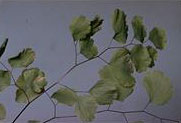
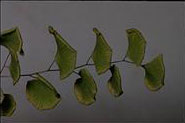
California
maiden-hair (Adiantum jordanii, Pteridaceae)
This fern spreads by short rhizomes. Its fronds
measure between 20 and 50 (possibly 70) cm.
(8 and 20 (possibly 28) inches). They are twice
or three times pinnately cut or lobed. Blade
segments are fan-shaped. Sporangia occur along
the veins and are covered by the recurved part
of the blade margin. Spores are tan-colored.
Adiantum
means "unwettable" in Greek. Jordanii
may refer to Alexis Jordan, a 19th century French
botanist.
|
|
*California sagebrush, coastal sagebrush
(Artemisia californica, Asteraceae)
click here
for description
|
|
image
unavailable
*Club-haired
or Yellow Mariposa lily (Calochortus
clavatus, Liliaceae) This showy wildflower
grows 50 to 100 cm. (20 to 40 inches) tall from
bulbs. Its 10- to 20-cm. (4- to 8-inch) leaves
are basal and wither before the plant blooms.
One to six erect flowers are arranged in an
umbel-like inflorescence. The three petals are
deep, vivid yellow against which background
the six purple anthers are prominent. The petals
measure approximately 5 cm. (2 inches) long,
each bearing a round nectary. They form a cup
within which there is a conspicuous ring of
club-shaped hairs over the nectaries. Blooms
appear from April through June. The fruits are
3-angled septicidal capsules. This Mariposa
lily is uncommon, but can be seen in Poly Canyon,
particularly in grassy serpentinite communities.
Calochortus
is Greek and means "beautiful grass." Clavatus
refers to the club-shaped hairs on the inner
surface of the petals.
|
|
image
unavailable
*San
Luis Mariposa lily, star tulip (Calochortus
obispoensis, Liliaceae) The San Luis Mariposa
lily is a splendid wildflower that grows 30
to 60 cm. (1 to 2 feet) tall from a bulb. Its
20- to 30-cm. (8- to 12-inch) basal leaves wither
before the plant blooms. The inflorescence is
erect and contains two to six flowers. The three
ovate petals measure about 10 to 20 mm. (1/2
to 1 inch) long. They are deep yellow to orange
and coarsely hairy inside, fringed, and bear
a dark tuft of hairs at the tip. Each petal
has a round nectary which is nearly hidden by
dense hairs. Blooming usually occurs around
late May or early June. These lilies grow on
rocky, grassy slopes in serpentinite and chaparral
communities. They are rare.
The
bulbs of the star tulip were eaten.
Calochortus
is Greek and means "beautiful grass." Obispoensis
refers to San Luis Obispo, California, the only
county where this species occurs. The San Luis
Mariposa lily is the logo for the local chapter
of the California Native Plant Society.
|
|
image
unavailable
San
Luis Obispo or Mouse-leaved Dudleya (Dudleya
abramsii ssp. murina, Crassulaceae)
This perennial has a simple caudex above the
soil surface. The evergreen leaves are somewhat
glaucous, oblong-lanceolate, and 3- to 11-cm.
(11/4-to 41/3-inch) long. There are fewer than
30 leaves per rosette, and fewer than ten rosettes
per plant. The 5-merous flower has pale yellow
8- to 13-mm. (1/3-to 1/2-inch) petals flecked
with purple, with a purple keel. The fruit is
a cluster of five erect follicles. The plant
exudes a purple dye when crushed. San Luis Obispo
Dudleya is uncommon. It grows on serpentinite
outcrops.
W.R.
Dudley, 1849-1911, was a botanist in the western
United States. Leroy Abrams was a botanist at
Stanford University. Murina means "mouse
gray" or "like a mouse."
|
|
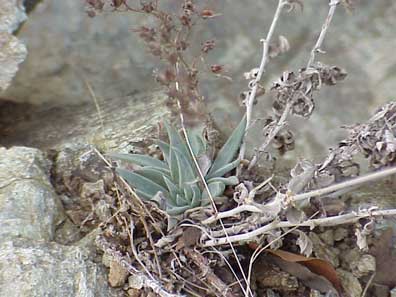
Dudleya
(Dudleya lanceolata, Crassulaceae) This
perennial has an erect caudex. The rosette of
5- to 30-cm. (2- to 12-inch) fleshy, oblong-lanceolate,
evergreen leaves. These may or may not be glaucous.
The inflorescence is a one-sided cyme. Flowers
have five bright yellow to red petals. Blooms
appear May through July. The fruit is a cluster
of five erect follicles. Dudleya is found on
rocky slopes.
W.R.
Dudley, 1849-1911, was a botanist in the western
United States. Lanceolata refers to the
shape of the leaves.
|
|
image
unavailable
Slender
buckwheat (Eriogonum elongatum, Polygonaceae)
This is a 6- to 18-dm. (2- to 6-foot) perennial.
Leaves are mostly basal, with some cauline.
The 10- to 30-mm. (1/2- to 11/2-inch) leaf blades
are elliptic, wavy-margined, and tomentose.
The inflorescence is cyme-like and open with
long, wand-like branches. The white flowers
are borne in small sessile clusters along the
branches. They measure about 1/4 cm. (1/10-inch)
across and bloom from August through November.
The fruit is a 2- to 3-mm. (1/8-inch), three-angled
achene.
Eriogonum
is Greek for "woolly knees," referring to the
hairy nodes of some species. Elongatum
means "elongate."
|
|
*California buckwheat (Eriogonum fasciculatum,
Polygonaceae)
click here for
description
|
|
Golden yarrow (Eriophyllum confertiflorum,
Asteraceae)
click here
for description
|
|
*Climbing bedstraw (Galium porrigens,
Rubiaceae)
click
here for description
|
|
image
unavailable
Small-leaved
lomatium (Lomatium parvifolium, Apiaceae)
This 11/2- to 4-dm. (6- to 16-inch) perennial
develops from a slender taproot. It has short
stems. Its three times pinnate leaves have spiny
toothed leaflets. The inflorescence is a compound
umbel containing flowers with yellow petals.
Fruits are 8- to 14-mm. (1/3- to 2/3-inch) elliptic
flattened mericarps. In Poly Canyon, small-leafed
lomatium is usually found growing in serpentinitic
soils.
Lomatium
is Greek for "bordered," referring to the prominent
marginal wing on the fruits. Parvifolium
means "small-leaved."
|
|
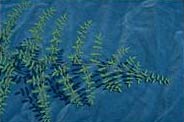
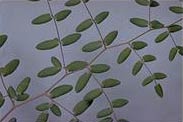
Coffee
fern (Pellaea andromedifolia, Pteridaceae)
This fern spreads by long, branched rhizomes.
The 20- to 60-cm. (8- to 24-inch) leaves are
bluish green to purplish gray. The blades are
generally three (possibly two or four) times
pinnately divided into many small leaflets.
Sporangia are found in bands near the curled-under
margins of the leaflets. Spores are tan to light
yellow.
Pellaea
is Greek for "dusky," referring to the bluish-gray
leaves. Andromedifolia means "leaves
like those of the genus Andromeda, Ericaceae.
|
|
*Goldback fern (Pentagramma triangularis,
Pteridaceae)
click here
for description
|
|
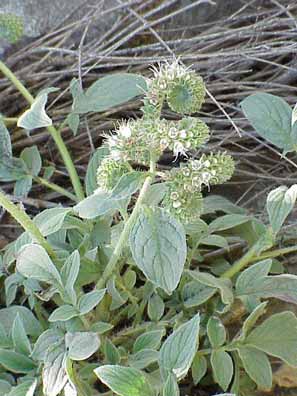
Phacelia
(Phacelia imbricata, Hydrophyllaceae)
This perennial has 20- to 120-cm. (8- to 48-inch)
stiff-hairy stems. The 50- to 150-mm. (2- to
6- inches) leaves are mostly basal. They are
narrowly lanceolate to ovate and are dissected
into three to 15 segments. The inflorescence
is a cluster of dense, coiled, one-sided cymes.
The flowers have a 4- to 7-mm. (1/6- to 1/4-inch)
corolla that is cylindric to bell-shaped and
white to lavender. The fruit is a stiff-hairy,
ovoid, and inconspicuous capsule.
Phacelia
is Greek for "cluster," referring to the dense
inflorescence. Imbricata means "overlapping,"
in reference to the overlapping calyx lobes.
|
|
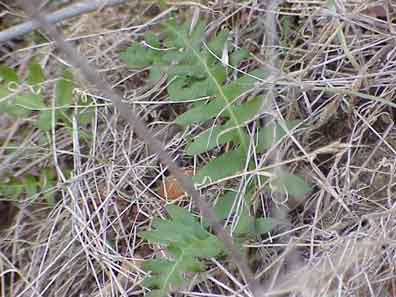
Common
polypody fern (Polypodium californicum,
Polypodiaceae) This is a perennial fern spreading
by rhizomes. Its leaves are summer-deciduous.
The 10- to 25-cm. (4- to 10-inch) blades are
deltate to ovate and are pinnately compound.
The leaflet blade margins are minutely serrate.
Sporangia are grouped in round sori on the underside
of the leaflets. The sori appear somewhat sunken
and have no indusium (covering).
Polypodium
is Latin and means "many-footed," referring
to the rhizomes. Californicum means "of
California."
|
|
Leather oak (Quercus durata, Fagaceae)
click here
for description
|
|
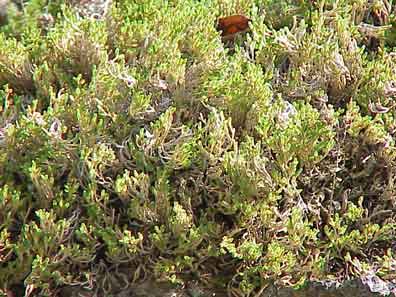
Spike-moss,
clubmoss (Selaginella bigelovii,
Selaginellaceae) This is a 5- to 15-cm. (2-
to 6-inch) tall mat-forming plant with ascending
to erect, clumping stems. Its tiny leaves are
6-ranked, overlapping, appressed, and scale-like,
linear in shape, and bristle-tipped. The margins
have somewhat rigid hairs. This is a non-flowering
plant tha produces spores in small, terminal
cone-like strobili. The sporangia are borne
in the axils of 4-ranked sporophylls (scale
leaves). Terminal cones are generally smaller
than 1 cm. (1/2 inch). These are lanceolate
to ovate in shape. There are two kinds of spores:
orange megaspores and much smaller yellow microspores.
During dry seasons, this plant may appear to
be dead, only to resume growth as moisture and
cooler temperatures return. Because of this,
it is sometimes called the resurrection plant.
Selaginella
is a diminutive form of the Latin word selago
which is the ancient name for some Lycopodium.
Bigelovii refers to Professor Bigelow of Boston.
|
|
image
unavailable
Silver
rock lettuce (Stephanomeria cichoriacea,
Asteraceae) This 5- to 15-dm. (20- to 60-inch)
perennial has a large root crown. Its stems
are tomentose. 5- to 18-cm. (2- to 7-inch) oblong
to lanceolate leaves grow in a basal rosette.
The leaves have mostly smooth edges (possibly
with a few teeth). The inflorescence is a pink-flowered,
dandelion-like head of ten to 15 florets. It
blooms in summer. The fruit is a five-angled,
smooth, brownish achene.
Stephanomeria
comes from Greek and means "wreath division."
Cichoriacea comes from cichoreum meaning
"endive."
|
|
*Yucca, chaparral yucca, Our Lord's candle,
Quixote plant (Yucca whipplei, Liliaceae)
click here for description
|
|